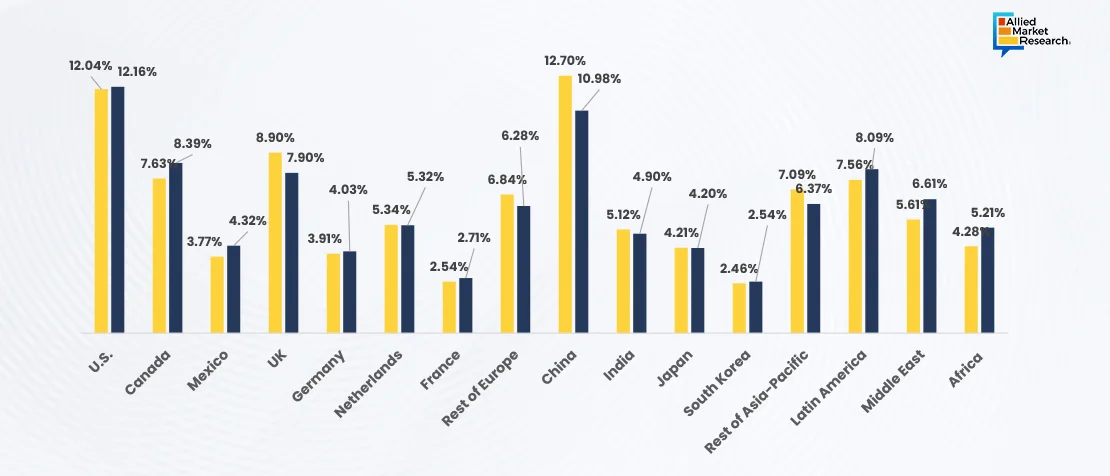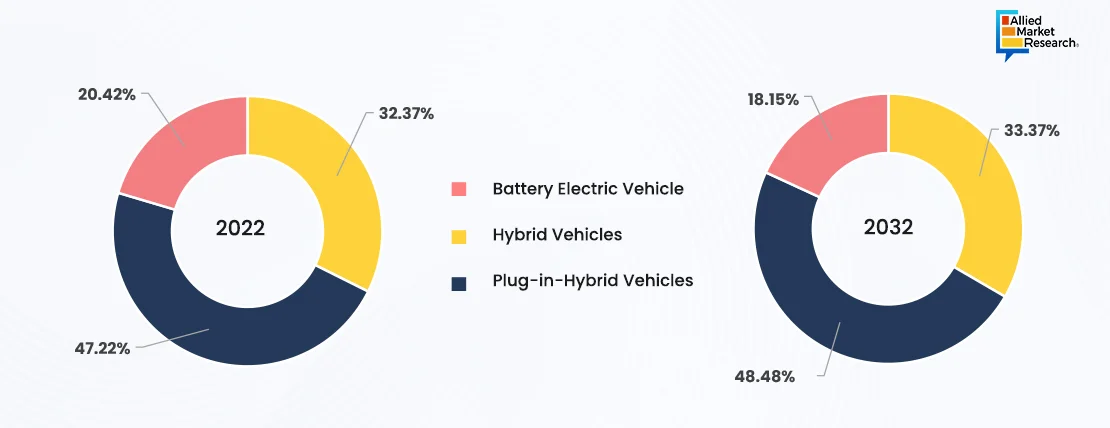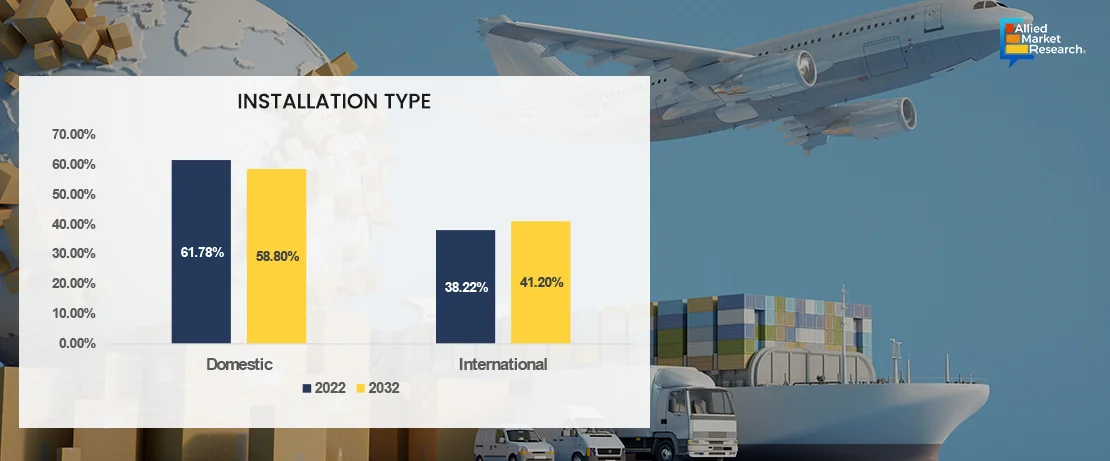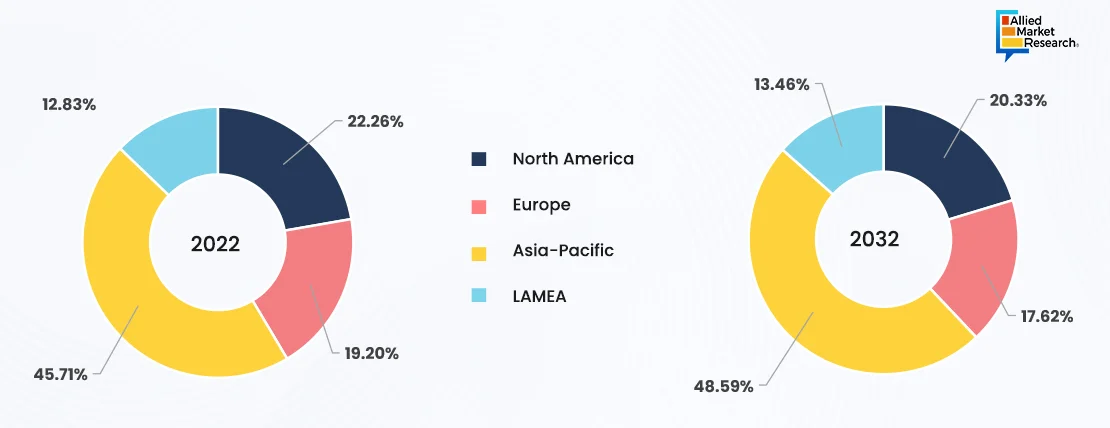Table Of Contents
- Connected Ship
- Country-level analysis of the connected ship industry
- Medical Courier
- Electric Vehicle Motor
- Pharmaceutical Warehousing
- Warehousing and Distribution Logistics
- Region wise breakdown of the warehousing and distribution logistics market
- Potential of emerging markets and competitive landscape
- Summing Up

Lalit Janardhan Katare

Pooja Parvatkar
Automotive and Transportation: Top 5 Emerging Markets in Q1 2024 by Allied Market Research

The automotive and transportation sector is gaining momentum as it undergoes significant transformations driven by various factors. The emergence of Connected, Autonomous, Shared, and Electric (C.A.S.E.) mobility is transforming traditional industry norms, resulting in the adoption of self-driving vehicles, electrification, ridesharing, advancements in charging and battery technologies, innovative business models, and digital tools. This evolution is driven by rapid technological advancements, shifting consumer preferences, strict emission standards, and heightened safety regulations, allowing automakers to upgrade their strategic directions.
Allied Market Research (AMR) has shortlisted the top 5 emerging markets in the automotive and transportation domain for the first quarter of 2024 by highlighting the most promising areas of expansion and investment.
AMR utilizes its internal 'Title Matrix Tool' to precisely identify and prioritize markets, utilizing predetermined criteria derived from research analysts and parallel teams. Reports are assessed based on their relevance, current significance, ongoing events, Compound Annual Growth Rate (CAGR), increasing client demand, importance of key players, market size, and other factors.
The main purpose of these reports is to address various business queries, including determining the current industry size and projecting future trends, identifying key drivers and opportunities, analyzing prominent participants and their strategies, assessing obstacles and potential risks, understanding regional variations, and examining the competitive landscape within the industry. Additionally, these reports incorporate retrospective analysis and historical data to provide a comprehensive understanding of industry dynamics.
Connected Ship
As per the report published by AMR, the connected ship market generated $6,801.3 million in 2022, and is expected to hold $12,262.0 million with a growing CAGR of 6.3% by 2032. The study incorporated high-quality data, expert opinions, and thorough independent analysis, aiming to offer a balanced perspective on global industries. The research approach is designed to assist stakeholders in making informed decisions to attain their ambitious growth objectives. Digitalization in maritime industry, IoT and connectivity, demand for operational efficiency, safety and security concerns, regulatory compliance, data-driven decision making, emergence of autonomous shipping, environmental sustainability and supply chain optimization are driving the demand for connected ship sector report.
The title "Connected Ship Market" is strategically significant to research at present due to several factors. These include industry transformation, operational efficiency, regulatory compliance, safety and security, competitive advantage, environmental sustainability, and technological innovation.
For investors, conducting research on the connected ship industry holds strategic importance. It allows them to navigate industry dynamics, streamline operations, ensure compliance with regulations, improve safety and security measures, gain a competitive edge, promote environmental sustainability efforts, and drive technological innovation.
Country-level analysis of the connected ship industry
The regional analysis in the report covers North America, LAMEA, Asia-Pacific, and Europe regions. It further elaborates the analysis based on countries in which it discusses major shareholding countries with driving factors and opportunities. These estimations deliver a brief idea of investment opportunities across particular regions.

Medical Courier
The medical courier market report is gaining popularity due to the specialized healthcare services, rise in healthcare demand, stringent regulatory requirements, growing importance of precision medicine, advancements in medical technology, focus on patient-centric care, rapid growth of e-commerce in healthcare, and COVID-19 pandemic impact. Due to these factors, the global medical courier industry is expected to garner $16237.27 million with 6.42% CAGR by 2032.
Retrospective analysis: Examining historical data, trends, and events is essential to grasp past developments in the medical courier industry. This analysis includes studying adoption rates, technological advancements, regulatory changes, and the performance of the industry. Retrospective analysis offers a thorough comprehension of past trends and current industry dynamics in the connected ship industry. This empowers stakeholders to make informed decisions and strategic investments.
A thorough analysis of industry segmentation for medical courier in the identification of current opportunities. The global industry for medical courier is categorized based on product type and service type with predictions on the most rapidly growing and revenue-generating segments within each category. For instance, by service type, domestic segment achieved the highest revenue in 2022 and is expected to maintain its dominance by 2032.

Electric Vehicle Motor
The demand for Electric Vehicle (EV) Motor industry reports is propelled by numerous significant trends and industry shifts. These involve government regulations and environmental concerns, advancements in battery technology, increasing consumer interest and demand, technological innovations, the transition within the automotive industry, infrastructure development, and supply chain dynamics. These trends highlight the importance of comprehensive report on the electric vehicle motor market.
Such reports offer valuable insights into industry dynamics, technological advancements, competitive landscape, regulatory developments, and growth prospects. They empower industry stakeholders to make informed decisions and utilize emerging opportunities in the electric vehicle sector. The sector is expected to cite a growing CAGR of 15.2% with absolute revenue of $99.5 billion by 2032.
Porter's Five Forces analysis underscores the significance of financial factors in shaping businesses' growth strategies. Additionally, it highlights the influence of buyers and suppliers, empowering stakeholders to make profit-centric decisions and strengthen their supplier-buyer network.
The hybrid vehicle segment is gaining popularity due to the use of two or more engines and stringent emission norms by governments across the globe. Hybrid cars are a transitional step between traditional ICE vehicles and fully electric vehicles, contributing to the increased demand in the sector.

Pharmaceutical Warehousing
Researching the pharmaceutical warehousing market is strategically significant at this moment due to various factors. These include global health concerns, the rapid expansion of the pharmaceutical industry, the complexity of pharmaceutical supply chains, technological advancements, emphasis on patient safety and product quality, regulatory compliance and quality assurance, optimization of supply chains for cost efficiency, as well as the pursuit of industry differentiation and competitive advantage.
In summary, conducting research on the pharmaceutical warehousing sector holds strategic importance for pharmaceutical companies, logistics providers, regulatory agencies, and other stakeholders. This research enables them to tackle current challenges, seize emerging opportunities, and guarantee the effective and secure distribution of pharmaceutical products to patients.
The bottom-up approach is employed to determine the overall industry size of the pharmaceutical warehousing sector by estimating revenue generation and industry value. This is achieved through a combination of secondary and primary research methods. The sector size obtained from the bottom-up approach serves as a foundation in the top-down approach to estimate the size of other segments outlined in the table of content. This involves deriving percentage splits from secondary and primary research data. Subsequently, the overall industry size derived from these methods is utilized in the top-down approach to estimate regional consumption.
Warehousing and Distribution Logistics
The global warehousing and distribution logistics market is projected to grab absolute revenue of $25,788.7 billion with a notable CAGR of 7.7% by 2031. The global warehousing and distribution industry is driven by Omnichannel Retailing, E-commerce Growth, Globalization of Supply Chains, Technological Advancements, Rise of Just-in-Time (JIT) and Lean Manufacturing, Sustainability Initiatives, Data Analytics and Predictive Analytics, and Last-Mile Delivery Challenges.
The Warehousing and Distribution Logistics sector is currently a strategically vital area for research due to various factors. These include the growth of E-commerce, disruptions in supply chains, advancements in technology, initiatives towards sustainability, challenges in urbanization and last-mile delivery, dynamics of globalization and trade, evolving customer expectations and experiences, and the importance of competitive differentiation.
The report offers a detailed competitive scenario of the warehousing and distribution industry. It comprises top business entities with their strategic alliances. This analysis involves top players including Gemadept, Yusen Logistics, Kuehne + Nagel, Ych Group, Kerry Logistics, WHA Corp, Keppel Logistics, AGILITY, Singapore Post, DB Schenker, Tiong Nam Logistics, DHL Supply Chain, CEVA LOGISTICS, CWT Ltd, and CJ Century Logistics. These organizations are at the forefront of innovation and sector expansion, driving the industry forward with their diverse product offerings and strategic partnerships. This information about key players in the global composite insulators industry offers businesses invaluable insights for making strategic decisions.
Region wise breakdown of the warehousing and distribution logistics market
Regional analysis covers the warehousing and distribution sector across Asia-Pacific, LAMEA, Europe, and North America. This regional analysis involves industry estimations with driving factors and opportunities. For instance, Asia-Pacific held the highest revenue in 2022 and is expected to retain its dominance by 2032. The growth is attributed to favorable government policies for development of logistics infrastructure in the region.

Potential of emerging markets and competitive landscape
Industry leaders can utilize these emerging market research findings to attain a competitive edge and improve strategic planning in various ways. This includes identifying sector opportunities, optimizing operational efficiency, minimizing risks and challenges, informing technology investments, enhancing customer value proposition, driving innovation and differentiation, establishing strategic partnerships, and adapting to regulatory changes.
Additionally, these reports offer market size data in terms of value, along with additional details such as regulation analysis, Porter’s five forces analysis, and pricing analysis. The competitive scenario presented in each report highlights the strategies of top players aimed at strengthening their market position.
The title "Connected Ship Market" is strategically significant to research at present due to industry transformation, operational efficiency, regulatory compliance, safety and security, competitive advantage, environmental sustainability, and technological innovation. The global medical courier sector report is strategically important due to the specialized healthcare services, rise in healthcare demand, stringent regulatory requirements, growing importance of precision medicine, and advancements in medical technology.
Global health concerns, the rapid expansion of the pharmaceutical industry, the complexity of pharmaceutical supply chains, technological advancements, emphasis on patient safety and product quality, regulatory compliance and quality assurance, optimization of supply chains for cost efficiency highlight the importance of the pharmaceutical warehousing industry.
Summing Up
The final deliverables of reports include detailed analyses of investment opportunities, recent trends, and the competitive landscape. These deliverables empower clients to gain a comprehensive understanding of the dynamic market. Additionally, they enable clients to evaluate opportunities, compare their strategies with competitors, and make informed business decisions.
For a detailed analysis of the automotive and transportation industry, contact our experts today!

